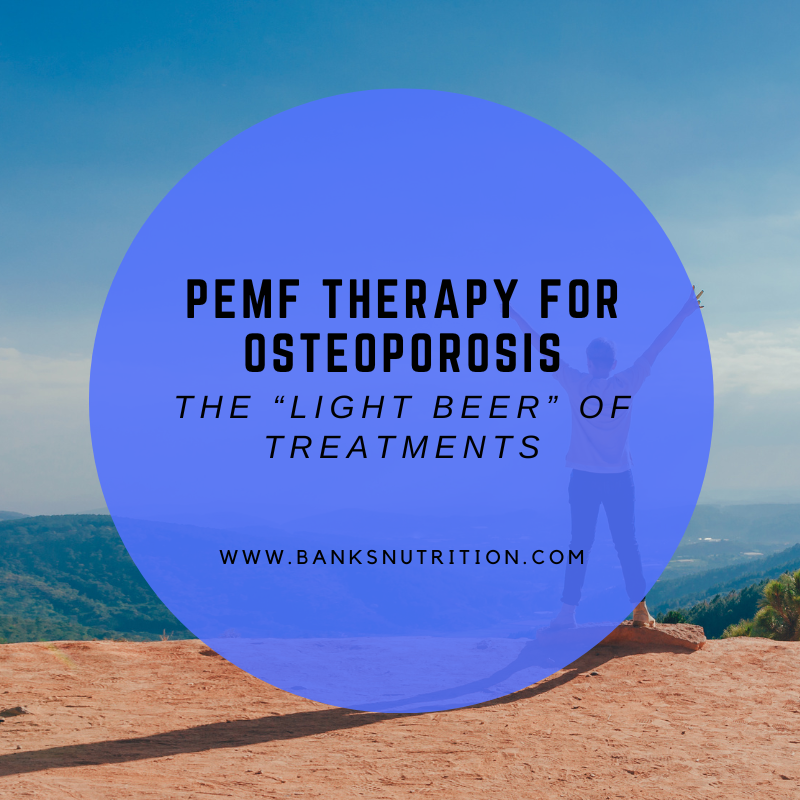
PEMF Therapy for Osteoporosis
April 17, 2024
My analogy here will likely only make sense to those 55 and older, the very population that faces an osteoporosis diagnosis. Many will be left with a choice of considering drug therapy or non-drug therapy. Many of the drugs available to treat bone density loss can be effective, but they carry some risk of adverse effects.
The available drugs for osteoporosis are broadly lumped into one of two categories, antiresorptive and anabolic. Bone density loss is the result of an imbalance of the activity in the cells that maintain bone strength in younger adults. Bone undergoes some wear damage on an ongoing basis. These areas are repaired by “remodeling” where osteoclasts remove the damaged bone and osteoblasts fill in new, healthy bone. In healthy young adults these cells work in balance, so bone is repaired back to normal density.
For some perspective on how important this remodeling process is to maintain bone strength, about 10% of the skeleton is rebuilt each year. The entire system is rebuilt each decade. Unfortunately, from approximately 35 years of age on, the bone removal activity of osteoclasts gradually increases while the bone generation by osteoblasts decreases resulting in a loss of bone density of 1-2% per year up till about age 55 where it accelerates.
The understanding of this remodeling has led to the development of two types of drug therapies, antiresorptives that try to slow bone removal and anabolics which try to increase bone generation. Both approaches are only working on one side of the problem, that of overactive osteoclasts or that of underactive osteoblasts. This concentration on only one side of the process decreases fragility fracture in the early phase (1-3 years) but does not fully restore the normal bone remodeling. This has been found to increase the risk of serious adverse events such as transverse fracture of the femur with extended use (>5 years).

While 1-year use of antiresorptive bisphosphonates was only associated with 1.78 transverse femoral fractures per 100,000 users, 8-9 year use increased those complications 113 per 100,000 users.(1) Using these drugs only 1-2 years allows the disease to then accelerate when they are discontinued.
In a summary of the studies looking into this problem the authors concluded, “These drugs work by suppressing bone turnover; however, in theory, prolonged use could suppress it too much and increase bone fragility.”(2)

By now many are saying what does all this have to do with light beer? Most in the 55 and older group remember the commercials trying to promote light beer as an alternative to the traditional beers. The early blowback against light beer was that it didn’t have the full taste of regular beer. The proponents countered this “less filling”. One of the first light beers to make a big splash into the market did entertaining commercials where two groups of professional sports personalities on opposite sides yelling back and forth, “tastes great, less filling”. The idea was that the beer would provide both.
So how does this fit into the non-drug therapy realm of treatment for osteoporosis? Pulsed electromagnetic frequency (PEMF) therapy is unique in that it is antiresorptive and anabolic. It both slows osteoclastic bone removal and accelerates osteoblastic bone repair. PEMF therapy has been shown to increase bone density between 20-30%, while drug therapy typically increases it 5-7% in the first year. This higher increase in bone density is thought to result from it working both at slowing the abnormal bone removal activity and restoring bone rebuilding activity. It is truly “less filling, tastes great”.
Schilcher J, Michaelsson K, Aspenberg P. BIOPHOSPHONATE USE AND ATYPICAL FRACTURES OF THE FEMORAL SHAFT. N Engl J Med 2011; 364(18):1728–1737.
Silverman S, Kupperman E, Bukata S. BIOPHOSPHONATE-RELATED ATYPICAL FEMORAL FRACTURE: MANAGING A RARE BUT SERIOUS COMPLICATION. Cleveland Clinic Journal of Medicine November 2018, 85 (11) 885-893.